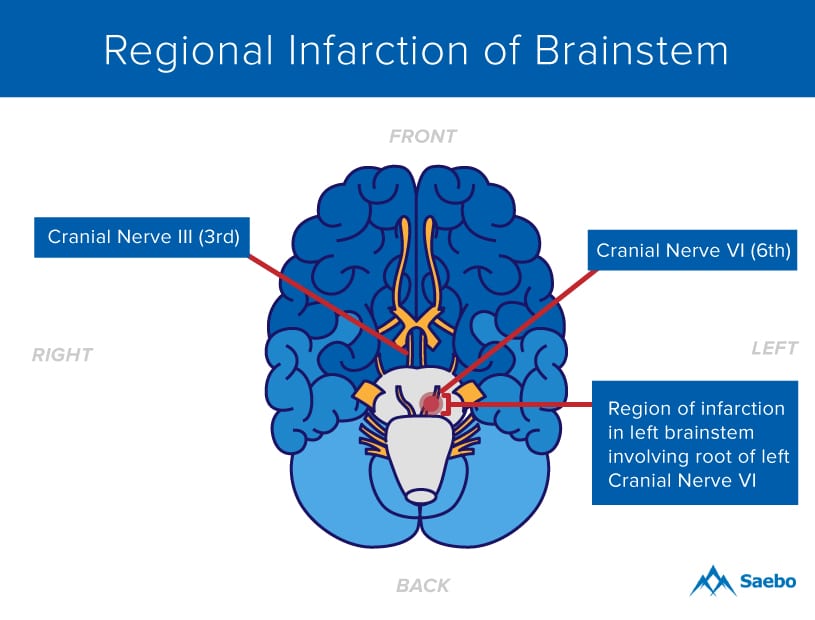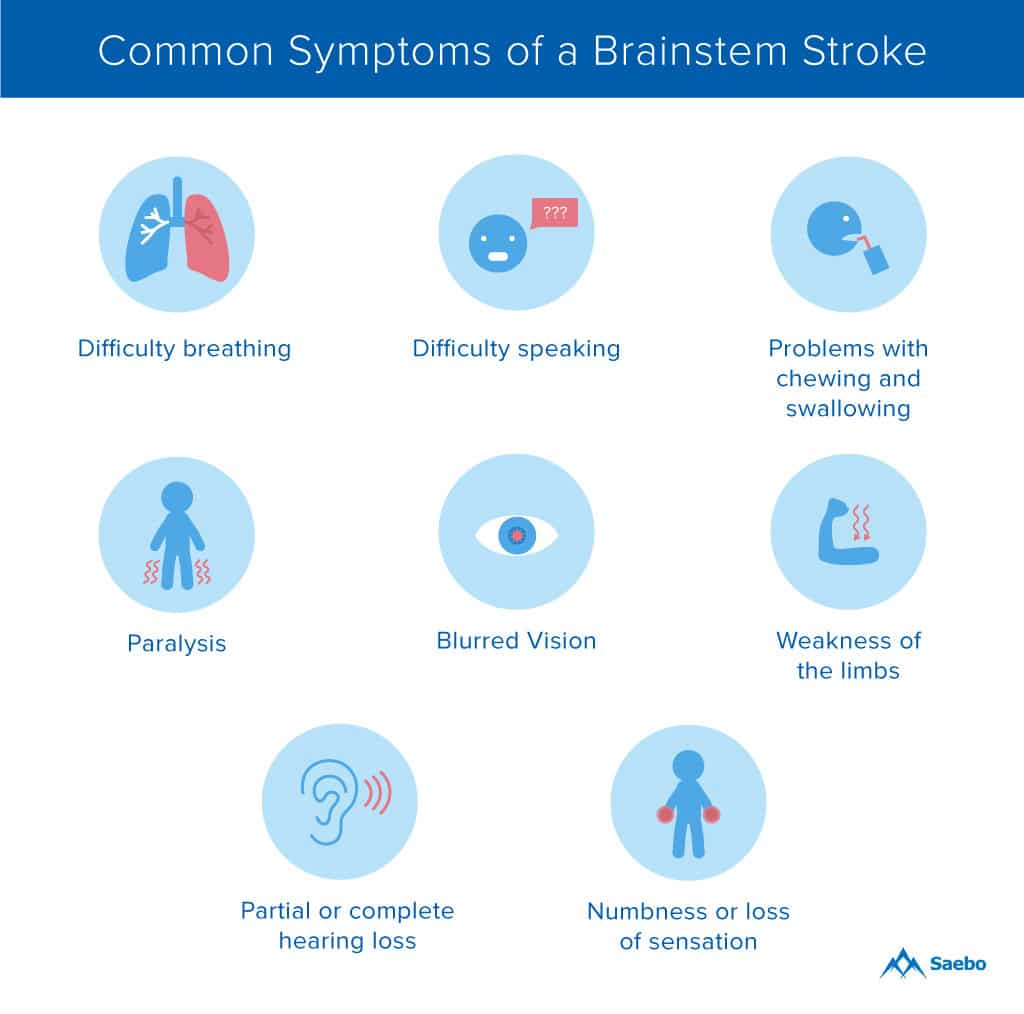What is a Brainstem Stroke?


A brainstem stroke can cause impairments in vital body functions, like breathing, heartbeat, swallowing, and speech, due to a blockage of blood between the brainstem and the brain. The effects can be catastrophic to a stroke patient and prove difficult to recover from.
Fortunately, fast treatment and beginning of the recovery process as soon as possible can make a significant difference in the well-being of a patient after a brainstem stroke. It's important that you learn why a brainstem stroke occurs, how it's diagnosed and treated, and what the proper after-stroke recovery is.
What is a Brainstem Stroke, Pons Stroke, or Brainstem Infarction?
Pons stroke and brainstem infarction are different names for brainstem stroke. A brainstem stroke is less common than a hemispheric stroke, but it is difficult to pinpoint where they start. However, this diagram shows how a brainstem stroke can happen by the highlighted area being deprived of blood:

This illustration shows a bottom-to-top perspective of a brainstem stroke:

What is the Brainstem (Pons)?
The brainstem is responsible for controlling the central nervous system and its functions, such as breathing, blood pressure, and consciousness. Your body's motor control must go through the brainstem before any motor functions are completed, such as raising your arm or pressing a button with your finger.
Therefore, a brainstem stroke can affect some, or all, of these functions. The complications of the stroke are usually predictable by doctors, and beginning recovery soon after a brainstem stroke can help the body restore these functions.
Signs of Brainstem Stroke
There are 5 key features of a brainstem stroke:
- Vertigo. Brainstem strokes interrupt the connection of the brain and cerebellum. The cerebellum controls face and body coordination so a disruption can lead to vertigo. If the patient has vertigo, it should immediately point toward a brainstem disorder.
- Presence of cranial nerve symptoms. The cranial nerves emerge directly from the brainstem. There are 12 pairs, all of which control motor and sensory information in the head and neck. Recognizing the cranial nerve symptoms can help determine where the stroke occurred. Common cranial nerve symptoms caused by a brainstem stroke are upward drifting in the affected eye, a dilated pupil, and double vision.
- Presence of crossed signs. In other words, this is presence of ipsilateral (same side) motor and sensory cranial nerve signs or symptoms and contralateral (opposite side) hemianesthesia (loss of sensation) and hemiplegia (weakness).
- Presence of oculomotor signs. The oculomotor nerve is a cranial nerve is part of eyelid movement and the eyes ability to focus on an object. Damage to this nerve can be recognized by what are know as ‘down 'n out’ symptoms, where the gaze of the affected eye is focused down and lateral of the unaffected eye.
- Bilateral simultaneous involvement of long tracts. This includes either sensory or motor, symmetric or asymmetric, simultaneous or sequential. For example, if there is a stroke patient who has simultaneous bilateral hemiparesis (weakness) or sequential hemiparesis, first on one side of the body and then after a while or the next day on the other side, it points to the brainstem.
Common symptoms of a brainstem stroke include:
- Difficulty breathing
- Difficulty speaking
- Problems with chewing and swallowing
- Partial or complete hearing loss
- Blurred vision
- Weakness of the limbs
- Paralysis
- Numbness or loss of sensation

How a Brainstem Stroke is Diagnosed
In addition to your healthcare provider asking general questions about your health and when possible symptoms first began, he or she may also check for signs of injury to the brainstem.
Your doctor could run the following diagnostic tests to find out if you've had a brainstem stroke:
- Arteriography. A test that involves the use of x-rays to check the arteries for leaks or blockages.
- CT Scan or MRI. These tests will take pictures of your brain that can help your doctor check for bleeds and blockages that may have caused, or could cause, a stroke. You may need to ingest a dye prior to having a CT or MRI, which will help the arteries show up better in the pictures.
How a Brainstem Stroke is Treated
For any type of stroke, quick medical care is of the utmost importance. The sooner you see your doctor if you suspect a stroke, the sooner you can receive the proper treatment and recovery care to prevent, or regain, loss of body functions. Because a stroke involves the brain, every second between a stroke and treatment counts.
Like other strokes, a brainstem stroke can have long-term health implications. You may need ongoing care, like therapies and medication. Speech therapy may be necessary to improve speech and oral communication with the brain. You may also need physical therapy to improve motor skills and occupational therapy to regain basic skills, like dressing yourself.
Time is of the Essence
The key to thriving after a brainstem stroke is to get medical care as soon as possible. Discuss your symptoms with your doctor, and be available for proper testing to help diagnose a stroke. The quicker you get on the road to recovery, the better your chances are of regaining your body functions and leading a healthy life.
All content provided on this blog is for informational purposes only and is not intended to be a substitute for professional medical advice, diagnosis, or treatment. Always seek the advice of your physician or other qualified health provider with any questions you may have regarding a medical condition. If you think you may have a medical emergency, call your doctor or 911 immediately. Reliance on any information provided by the Saebo website is solely at your own risk.
All content provided on this blog is for informational purposes only and is not intended to be a substitute for professional medical advice, diagnosis, or treatment. Always seek the advice of your physician or other qualified health providers with any questions you may have regarding a medical condition. If you think you may have a medical emergency, call your doctor or 911 immediately. Reliance on any information provided by the Saebo website is solely at your own risk.



